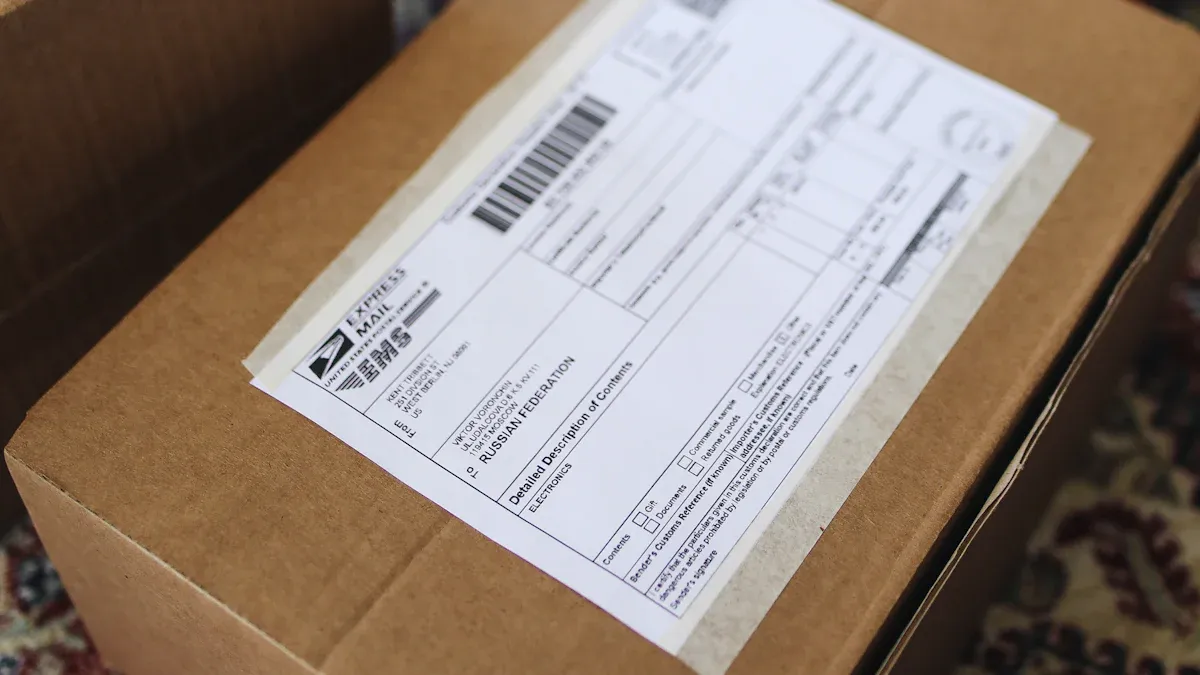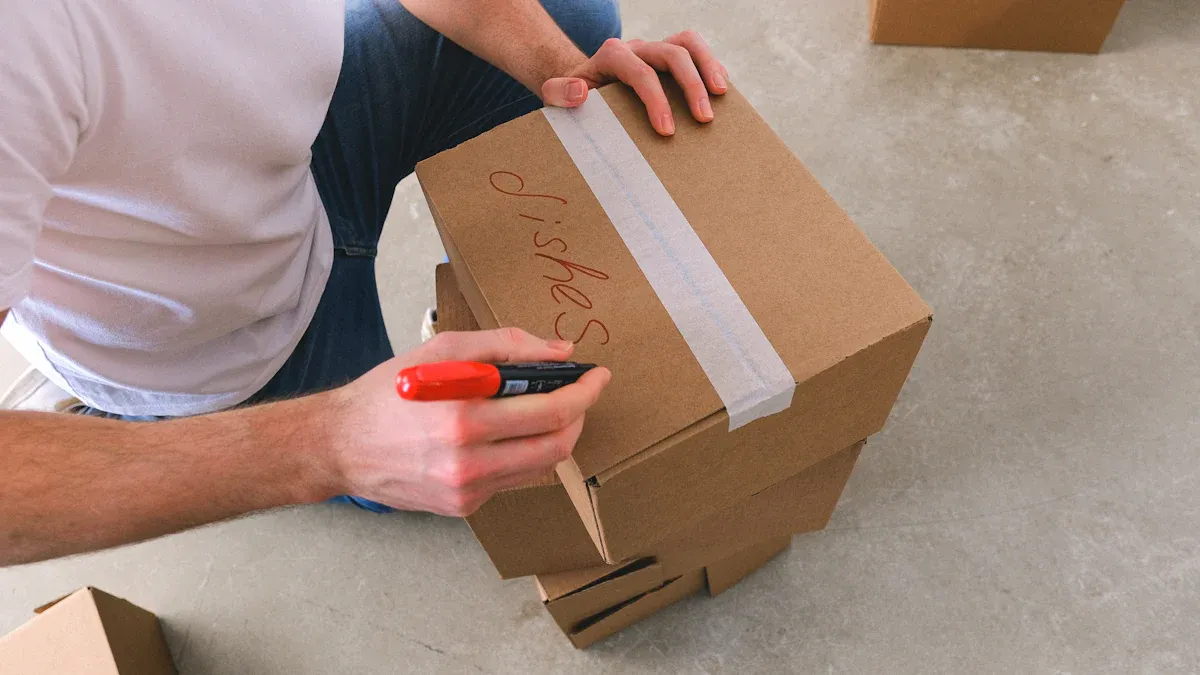Post Label Meaning What You Need to Know

You often see a post label on packages. Post label meaning refers to the information printed on a sticker or paper that helps with mailing or shipping. This label shows details like addresses and tracking numbers. You need to understand the label to make sure your shipping goes smoothly. When you use the right label, the shipping company knows where to send your package. Tracking works because the shipping label gives each parcel a unique code.
Post Label Meaning
What Is a Post Label
You see a post label on almost every package you send or receive. The post label meaning refers to the printed information that guides your package from the sender to the recipient. This label acts as the package’s identity card. It tells postal workers and machines where the package comes from, where it needs to go, and how it should get there.
A shipping label usually includes several important details. You find the sender’s and recipient’s names and addresses, including postal codes and country names. International standards require the country name to appear in full and in capital letters on the last line of the address. This helps postal services route your package correctly, especially when shipping across borders. The label also shows a tracking number or barcode, which lets you follow your package’s journey. You often see package weight, dimensions, and sometimes a description of the contents. For international shipping, the label may list the country of origin, HS code for customs, and special markings if the package contains fragile or hazardous items.
Tip: Always check that your shipping label matches the carrier’s requirements. Mistakes can delay your package or cause it to get lost.
Here is a table showing the most common elements found on a post label:
| Element | Description |
|---|---|
| Origin and Destination Addresses | Sender and recipient addresses, package weight, and number of packages. |
| Unidirectional Code (QR/MaxiCode) | Machine-readable code for routing packages efficiently. |
| Destination Details | State abbreviation, zip code digits, and internal carrier region codes. |
| Carrier and Service Information | Carrier name and shipping method (e.g., UPS Ground, Next Day Air). |
| Tracking Number | Unique alphanumeric code to track package progress. |
| Primary Barcode for Tracking | Barcode scanned at each stage to update tracking information. |
| Billing Option | Shows payment method for shipment (pre-paid, third-party, freight collect). |
| Reference Information | Optional shipper details like item numbers or category info to streamline processing. |
Why Post Labels Matter
You need to use the correct post label for every shipment. The post label meaning goes beyond just an address. It ensures your package moves smoothly through the shipping process. When you use a proper shipping label, you help postal workers and machines sort and deliver your package faster. The tracking number or barcode on the label lets you and the recipient check the package’s status at any time.
Shipping labels play a key role in e-commerce. Online sellers rely on accurate labels to keep customers happy and avoid lost packages. If you ship internationally, the label must follow strict rules. For example, the country name must be clear and not underlined. The label may also need customs information, such as the value and description of the goods.
You can find these details on most shipping labels:
- Sender and recipient names and addresses, with postal codes and country codes
- Tracking number or barcode for scanning
- Package weight and size in metric units
- Description and value of contents, often in English or the destination language
- HS code for customs and country of origin
- Special symbols for fragile, hazardous, or perishable items
A clear and accurate label helps prevent delays, lost packages, and extra fees. You make shipping easier for everyone when you pay attention to the details on your shipping label.
Shipping Label Details

Information on Shipping Labels
When you prepare a package for shipping, you need to include all the right details on the shipping label. Major carriers like FedEx, UPS, and DHL require you to provide the recipient’s full name, address, postal code, and city. You also need to add your own details as the sender. Most carriers ask for a barcode and a unique package number for tracking. If you miss any of these, your package could get delayed or returned.
Here is a checklist of what you should include on shipping labels:
- Recipient’s full name and company name (if needed)
- Complete delivery address, including postal code and city
- Sender’s full name and address
- Valid phone number and email address for both sender and recipient
- Clear description of the shipment contents
- Exact weight and dimensions of the package
- Tracking number or waybill number
- Special handling or delivery instructions (like “fragile” or “perishable”)
- Customs information for international shipping
Tip: Always use the carrier’s label template and follow their placement rules. This helps avoid scanning errors and extra charges.
Shipping labels play a big role in international shipping. Customs officers use the information on the label to check if your package meets all legal requirements. You must include a detailed description of the goods, the country of origin, and the correct HS code. Customs uses this data to decide if your shipment is legal, what taxes or duties apply, and if they can release it. If you leave out important details or make mistakes, customs may delay or even reject your package.
Shipping labels also help with safety and legal compliance. Some products, like hazardous materials, need special markings and warnings. For example, if you ship chemicals or batteries, you must add diamond-shaped hazard labels and the correct UN identification number. You may also need to include special instructions or extra labels for items like dry ice or explosives. Always check the rules for your product and destination country.
| Shipping Label Requirement | Why It Matters |
|---|---|
| Full sender and recipient details | Ensures correct delivery and return |
| Accurate weight and dimensions | Helps with shipping cost and carrier handling |
| Tracking number/barcode | Enables real-time tracking and updates |
| Customs and content description | Required for international shipping and safety |
| Special handling instructions | Prevents damage and ensures proper care |
If you run an e-commerce business, you need to pay close attention to these details. Accurate shipping labels help you avoid lost packages, unhappy customers, and extra fees.
Barcodes and Tracking
Barcodes are a key part of every shipping label. You see them as black and white lines or squares printed on the label. These codes store important data about your package. When a carrier scans the barcode, the system updates your package’s location and status in real time.
You will find two main types of barcodes on shipping labels:
- Linear (1D) barcodes: These look like a series of vertical lines. Code 128 is a common example. It holds tracking numbers and links to databases with your shipping details.
- Matrix (2D) barcodes: These look like squares or patterns, such as QR codes or MaxiCodes. They can store more data, including URLs and extra shipment information. They also scan quickly, even if the label is damaged.
Carriers use these barcodes at every step of the shipping process. When your package arrives at a warehouse, sorting center, or delivery truck, workers scan the barcode. Each scan updates a central database. You can then track your package online and see where it is at any time.
Barcode scanning is much more accurate than manual data entry. Manual entry can cause about 1 error in every 300 keystrokes. Barcode scanning reduces errors to as low as 1 in 36 trillion scans. This high accuracy helps prevent lost or misrouted packages and keeps your shipping reliable.
Note: Always place the barcode on a flat, visible part of the package. Avoid covering it with tape or placing it near seams or edges. This helps scanners read the code easily.
Shipping labels must also meet legal and safety rules. Some countries require labels in multiple languages, special hazard symbols, or certain font sizes. If you ship hazardous materials, you must use extra labels and markings, such as diamond-shaped hazard labels and UN numbers. These rules help keep everyone safe and ensure your package moves smoothly through customs and delivery.
Shipping labels and their barcodes make modern shipping fast, safe, and trackable. When you use the right label and follow best practices, you help your package reach its destination without problems.
Shipping Label vs. Mailing Label

Key Differences
You might wonder if there is a real difference between shipping labels and mailing labels. The answer is yes, and knowing these differences helps you choose the right label for your needs. Here is a table that shows the main differences:
| Aspect | Shipping Label | Mailing Label |
|---|---|---|
| Purpose | Used for parcels and packages; helps carriers sort and deliver items quickly | Used for letters, flats, or smaller mail pieces; often for regular mail and business materials |
| Information Included | Sender and recipient addresses, tracking numbers, barcodes, routing codes, service levels | Sender and recipient information; sometimes postage or delivery instructions |
| Complexity | More complex, unique for each shipment, includes electronic tracking features | Simpler, often used with common label-making software |
| Usage | Essential for parcels and expedited shipments | Used for regular mail; can be printed using common desktop printers |
| Label Format | Typically 4"x6" or 2"x7" labels with barcodes and tracking numbers | Adhesive labels, often plain address labels |
| Carrier Requirements | Must follow carrier-specific templates for sorting and delivery | Generally follow postal regulations but less complex than shipping labels |
Shipping labels contain more details than mailing labels. You see barcodes, tracking numbers, and even package weight on a shipping label. Mailing labels focus on the recipient’s name and address. You do not find tracking information or barcodes on mailing labels. Most mailing labels are simple and easy to print at home.
Tip: Always check if your package needs a shipping label or a mailing label before you send it.
When to Use Each
You use mailing labels for letters, postcards, newsletters, and small packages. Mailing labels also work well for labeling files, folders, or samples in your office. You can print mailing labels on sheets and stick them to envelopes or small parcels. These labels are perfect for simple addressing and branding.
You need a shipping label when you send boxes, large packages, or anything that needs tracking. Shipping labels are required for parcels that travel with carriers like USPS, UPS, or FedEx. Each shipping label is unique and includes a barcode for tracking. Carriers scan these labels at every step of the shipping process. This helps you and the recipient track the package online.
-
Use mailing labels for:
- Letters and postcards
- Newsletters and business mail
- Small packages and envelopes
- Office organization and ID tags
-
Use shipping labels for:
- Boxes and large parcels
- Items that need tracking or insurance
- Shipments with special handling or carrier requirements
Mailing labels make addressing easy for everyday mail. Shipping labels make sure your packages arrive safely and can be tracked from start to finish.
How to Create Shipping Labels
Steps to Make a Shipping Label
You can create a shipping label quickly by following a few simple steps. Most online carriers and shipping label software make the process easy. Here is how to create shipping labels for your packages:
- Log in or sign up for a shipping label maker or your carrier’s website.
- Enter the sender’s and recipient’s addresses, including contact information.
- Add package details like weight, dimensions, and shipping date.
- Choose your shipping carrier and compare rates.
- Select extra services if needed, such as insurance or delivery confirmation.
- Enter payment information and pay for postage.
- Download or save your shipping label as a PDF.
If you ship internationally, you must include customs forms, item descriptions, values, and HS codes. For hazardous materials, add hazard labels and handling information. Using a shipping label template helps you avoid mistakes and ensures your shipping labels meet carrier requirements.
Tip: Automated shipping label software reduces errors and speeds up the process, especially for e-commerce businesses handling many orders.
How to Print Shipping Labels
Once you have created your shipping label, you need to print shipping labels that are clear and scannable. Here are some best practices for how to print shipping labels:
- Use high-quality label stock that matches your printer type.
- Print at high resolution for sharp barcodes and text.
- Allow ink to dry before attaching labels, especially with inkjet printers.
- Place shipping labels on a clean, flat surface. Avoid seams, edges, or corners.
- Secure all edges and avoid covering barcodes with tape.
You can use thermal printers for high-volume shipping or inkjet and laser printers for smaller batches. Many shipping label software options let you print in batches or reprint labels if needed. Always use a shipping label template that fits your package and carrier standards.
Prepaid shipping labels require you to print and attach the label yourself. Labelless shipping offers a modern alternative. With labelless shipping, you receive a QR code on your phone and show it at the drop-off point. This method saves time and reduces paper waste.
Note: Always double-check your shipping labels for accuracy before shipping. Mistakes can cause delays or lost packages.
If you want to know how to place shipping labels, always put them on the largest flat side of the package. This helps scanners read the barcode easily and keeps your shipping on track.
You can improve delivery success by using clear, high-quality shipping labels and double-checking all address details. Always include a return address and choose tracking services for peace of mind. Carriers recommend following their label size and barcode placement rules to avoid delays. Try online shipping tools to create accurate labels and stay updated on carrier requirements. Labelless shipping helps reduce waste and supports a greener environment.
FAQ
What happens if you put the wrong address on a shipping label?
If you use the wrong address, your package may get delayed or lost. Carriers might return it to you. Always double-check the address before printing your label.
Can you reuse a shipping label?
You should not reuse a shipping label. Each label has a unique tracking number. Reusing it can cause confusion and delivery errors.
How do you remove a shipping label from a box?
Peel the label off slowly. If it sticks, use a hair dryer to warm the adhesive. You can also cover the old label with a new one if removal is too hard.
Do you need a printer to create shipping labels?
You do not always need a printer. Some carriers offer labelless shipping. You can show a QR code at the drop-off point, and they print the label for you.
What is the best way to attach a shipping label?
Tip: Place the label on the largest flat side of your package. Make sure the barcode stays clear and uncovered. Use strong tape around the edges if needed.
See Also
Understanding White Glove Delivery And Its Importance Today
Frequently Asked Questions About Customs Handovers Explained
Essential Facts About Court Minute Orders For 2025